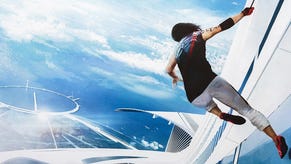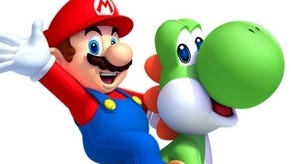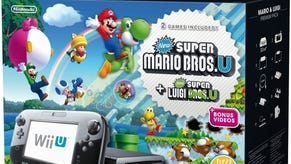New Super Mario Bros. U review
Boost in show.
Mario's latest outing does some clever stuff with the Wii U's multiple screens, but it's worth taking a moment to appreciate what it gets up to with good old-fashioned maps, too. The plumber's new 2D adventure sees the return of the fully-fledged world map, last seen in the 16-bit era. Islands, forests, babbling brooks and tidy oceans: the Mario atlas is back in fine, charismatic form, ditching the mostly-linear corridors of recent over-worlds in favour of a cluster of colourful, interconnected continents. It stitches dozens of scattershot stages together into a mad, sprawling and yet oddly convincing whole.
Does 2D Mario require a proper map? Not in the traditional sense: it's hard to get lost when you're en route from Acorn Plains to Frosted Glacier, so long as you take that crucial right-hand turn at the Layer-Cake Desert. This particular map isn't there to limit confusion, though, it's in place to pull the motley collection of gimmicks, in-jokes and nutty one-off ideas that make up a Mario game - especially one that comes on odd new hardware - into some kind of shape. Its job is to offer choices, junction points, alternate routes and secrets to hunt for as you move deeper into the adventure.
The map's riddled with playful surprises. One section here sees you ducking penguins as they slide along on their bellies and another sees you advancing across a wooden lattice with various Mushroom Kingdom critters matching you, move for move, on the opposite side. Occasionally there will be a mysterious level-sized gap that your nagging brain won't quite allow you to forget. Frequently, Nabbit, a thief with a distinctly Miyazaki-esque design, will raid a nearby Toad House and you'll have to chase him through a stage you've already completed. All the while, the world map gives Mario's latest adventure room to breathe, providing a fresh collection of 2D stages with a sense of identity that other New Super Mario Bros. instalments have sometimes lacked.
The map makes your progress feel like actual exploration, just as it did back in the old days. At times, it even allows you to mistake the newest entry in a series that often feels like a dry spin-off for a true sequel to the classic NES and SNES titles. It's a little addition on the surface, but it makes a huge difference to the overall feel of the game.
"The map makes your progress feel like actual exploration, just as it did back in the old days... It's a little addition on the surface, but it makes a huge difference to the overall feel of the game."
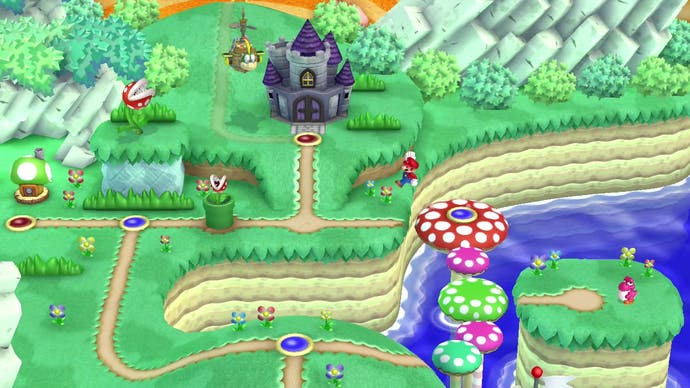
Thankfully, where the map leads, the level designers have followed, offering a range of inventive treats that benefit from the best of the older Mario games' ideas - and the increased resolution and power offered by the Wii U. The new hardware's grunt isn't seen in the assets and animations themselves, necessarily (although it's nice to be able to tell for the first time that the red double doors to a boss room have a leathery texture to them). Instead it's there in the sheer size of the playing area on the screen and the amount of chaos that can now be crammed into it. Armies of Koopas, fleets of airships, countless ranks of Goombas and skidding penguins: these population spurts add up over time, and while the game may not look radically different to New Super Mario Bros. Wii, the scale and sharpness still afford it a certain next-gen feel. Next-gen for Nintendo, at least.
HD visuals are only one part of the Wii U's appeal, of course. Play on your own and you can switch back and forth between the TV and the GamePad screen. Throw the main campaign open to up to four friends in local co-op, however, and Mario, Luigi and a couple of Toads are relegated to Wii remotes. The GamePad, meanwhile, busts out the stylus and becomes home to Boost Mode, turning whoever wields it into a pared-back Mushroom Kingdom dungeon master. They'll have no tubby little athlete of their own to control but they're free to mess with the world in a handful of pleasing ways, tapping the screen to stun enemies and create - this feels like heresy - up to four additional platforms at any one time.
This extra platforms stuff doesn't sound much fun on paper, but my first few hours playing around with Boost Mode passed in the kind of giddy blur I normally have to rely on Valium for. It's co-op at its most slapstick - and its least, y'know, co-operative. For the first few minutes, honestly, I just wanted to be helpful. I wanted to aid an ally's ascent by dropping steps into the landscape for them, and catch them whenever they went for a tumble. That was all very noble, but it only took one fortuitously misplaced tap of the screen to reveal the dazzling force of anarchy I could become if I used my new block-dropping powers for evil. As the candy-coloured worlds scrolled past, I bricked my friend up, halted his pixel-precise leaps by crafting unexpected ceilings and even caged enemies in place, setting them free at exactly the worst moment. It was frantic and mean-spirited and darkly hysterical, but it was still Super Mario Bros.
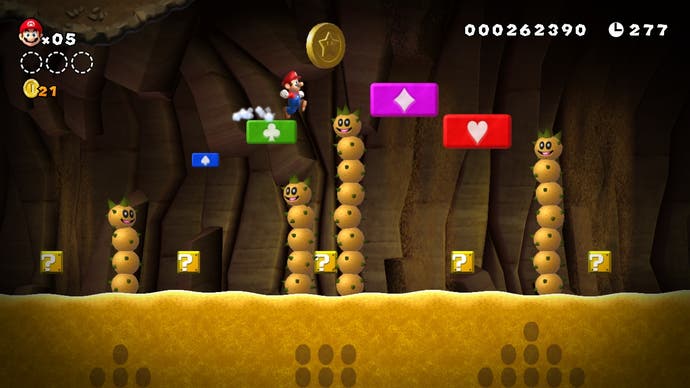
In truth, Boost Mode supports almost any approach you bring to it: it allows you to reach inside Mario's world at short notice to serve, to hinder, to simply confuse. It's genuinely hard to say whether it truly makes things easier or harder for those holding Remotes; either way, it can't unbalance a game that's already so hectic, so physical, so gleefully unpredictable that a major change to the rules simply becomes another system for you to muddle around with.
The campaign stages are more creative than most things the New Super Mario Bros. series has offered to date. There's a mountainside scattered with stiff little bubbles of water for you swim through in order to advance and there's a squadron of glossy flying beetles who provide stepping stones for you on a lofty scrolling level. There's a dark stage where the only light sources come from lamps stuck on the ends of - uh-oh! - see-saws and there are forests where huge bipedal walking plants lope across the landscape, releasing coins if you hit them in just the right spot from the underneath. In caverns, you'll find levels where the floor is made from spars of plasticky crystal that shift whenever you jump; in castles, you'll encounter genuinely evil congregations of sliding, climbing, tumbling walkways, strung between electrical nodes and furious rivers of lava.
There's only one new power up by my count (not including the return of the Baby Yoshis, who all come with special abilities that are too good to spoil) but it's a nice addition nonetheless. The Flying Squirrel suit provides you with a neat little fur hat and cape (they give Mario a rather Soviet air), as well as the ability to glide across long distances. It's a speedier beast than the Tanooki suit, and it boasts a couple of smart tricks. A squeeze of the GamePad trigger or a shake of Wii Remote will provide a sudden spike in altitude, and you can stick to any walls you come into contact with on your way down.
"With or without Boost Mode, New Super Mario Bros. U is the most challenging Mario game in absolutely ages."
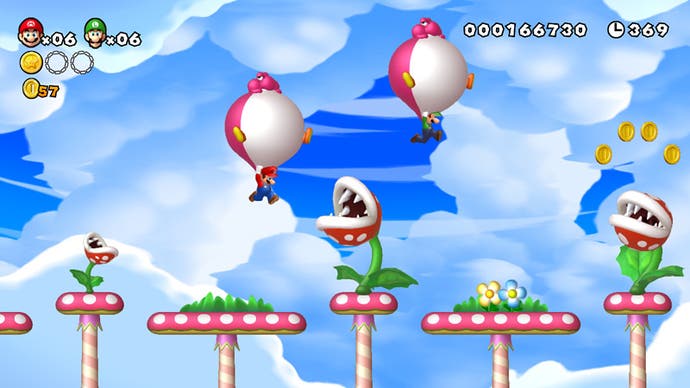
You'll really need the Flying Squirrel - just as you'll really need the returning Penguin suits, Fire and Ice Flowers, reworked Mini Mushrooms and other tricks - because, with or without Boost Mode, New Super Mario Bros. U is the most challenging Mario game in absolutely ages.
It's a pleasure to have to master this calibre of level design again - and beyond the campaign, you'll discover the plumber's been picking up some wonderfully nasty tricks that will push your skills to their absolute limits. They come in the form of a suite of arcade-tuned additional modes that build on the template laid down by Coin Rush in New Super Mario Bros. 2.
First up are the challenges: a series of single-player (or single-player and Boost player) affairs that focus on the likes of time attacks, coin collections and 1-Up rallies, which might see you trying to stomp on Goombas without touching the ground or defeating multiple enemies in a single, unbroken ice slide. These things feel like the Mushroom Kingdom equivalent of the Spec Ops content in COD games: they're extra-curricular treats where the real skills are displayed. You can race through them as your Mii, but it looks so desperately wrong that I urge you not to. Ever.
Next is Boost Rush, which sees up to four players racing across groupings of stages, fighting each other out of the way for coins that, when collected, will increase the speed at which the screen auto-scrolls. It's Coin Rush through the Wii U blender, in essence, and if you get a real meanie as the fifth player on the GamePad, it's an absolute bloodbath.
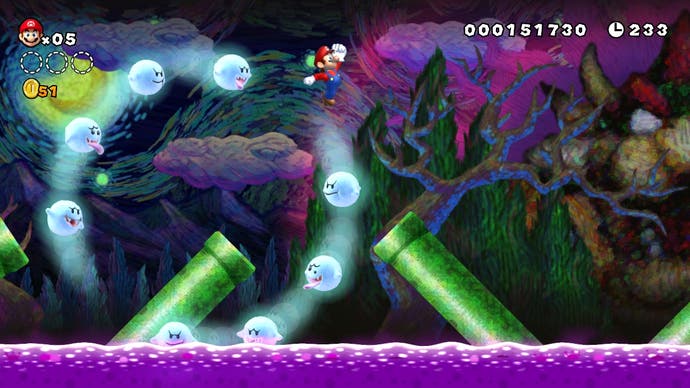
Speaking of bloodbaths, Coin Battle finishes things off in a spirit of delightful antagonism: it's a straight four-player dash for the most cash through a series of artfully nostalgic levels, some of which date all the way back to the days before the Mario Bros. had even earned the prefix 'Super'. As party games go, it's the rival of anything on Nintendo Land. It will make you scream and shout like only a Mario game can.
The package probably sounds a little disparate by this stage, but it actually feels like the most coherent New Super Mario Bros. game yet. It's certainly the most confident, whether it's playing around with physics, multiplayer design or - as ever - its own history. It brings Bullet Bill and Banzai Bill out of cold storage, for example, and throws in a new torpedo Bill variant that seeks you out underwater, while elsewhere it lets you race around on Yoshi for a bit and carry those hungry Yoshi babies across levels for as long as you can keep hold of them.
Throughout the game's tricks and feints, you can't help but marvel at how Mario's worlds can be so choreographed - from the perfectly-paced dances of the Koopa patrols to the piston pumps of multiple moving platforms that make you feel like a fat little cog in a giant machine - and yet allow for such creativity and freedom as you play. More than ever, Mario's designed to flit in and out of the tempo of the stages he moves around here - to be in sync when he's stepping on a Koopa and sending its shell into a chain of foes, and to be fiercely, hilariously unrhythmical when he's blasting his own path through blocks or back-flipping away from certain death.
Is the plumber's Wii U debut as good as his recent 3D outings? Not quite, but for the New Super Mario Bros. series, it's a real step forward in detailing, imagination and character. There's always been a keen Mario brain working away inside these 2D design exercises. Now, it feels like there's a proper soul to go along with it.
This game was played for review at Nintendo's UK offices before we received our own Wii U. No other press were present, we received no hospitality and we covered our own expenses.


